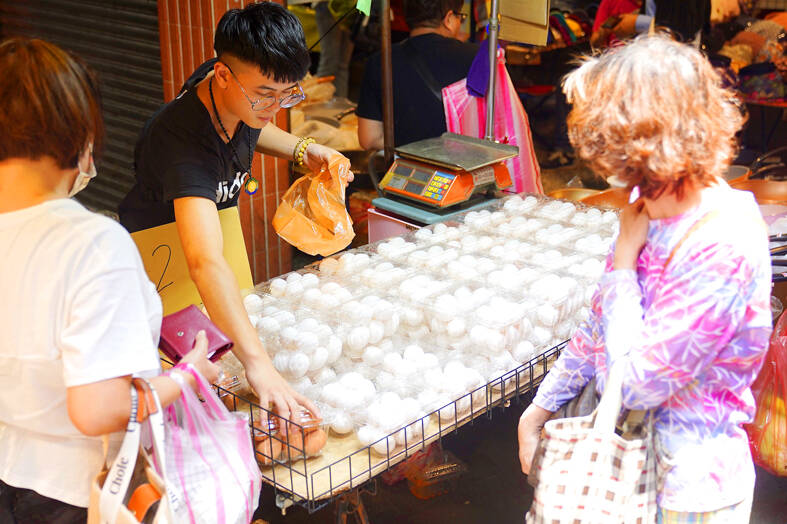The consumer price index (CPI) last month rose 2.35 percent from a year earlier, easing from a 2.43 percent increase in February and driven mainly by more expensive food and entertainment, the Directorate-General of Budget, Accounting and Statistics (DGBAS) said yesterday.
The latest CPI data suggest that inflationary pressure remained high, especially for frequently purchased items whose prices rose 6.12 percent, the agency’s monthly report showed.
“Inflationary pressures would remain tight in the near term and average people would feel the pinch more distinctly,” DGBAS official Tsao Chih-hung (曹志弘) said.

Photo: CNA
Food prices, the largest CPI component, grew 4.86 percent, as egg prices soared 26.52 percent, gaining by double percentage points for 17 months in a row, Tsao said.
Increased feeding costs pushed up egg prices, which are expected to gradually stabilize with egg imports, but the market needs time to adapt to the changes, he said.
Similar reasons contributed to a 5.75 percent increase in meat prices, he said.
Cooking oil and fruit prices rose 9.56 and 11.8 percent respectively, while the cost of dining out increased 4.08 percent after falling below the 4 percent mark in the previous two months, Tsao said.
Education and entertainment, another major CPI driver, gained 2.79 percent as recreational costs rose 6.46 percent after authorities further eased COVID-19 restrictions, the report said.
Shelter costs increased 2.3 percent as landlords raised rents, and as home repair and improvement became more expensive, it said.
Transportation and telecommunication costs declined 0.78 percent after international fuel prices fell 6.74 percent, it said.
Falling energy and raw material prices would help mitigate inflationary pressures this quarter, but rapid, steep easing is unlikely, Tsao said.
Core CPI expanded 2.55 percent, faster than the headline value after stripping volatile items, it said.
The producer price index (PPI), which measures price changes from a seller’s perspective, gained 0.05 percent, after prices for exports and imports softened whether measured by the US dollar or the local currency, it said.
For the first quarter, the CPI registered a 2.62 percent increase, while the PPI rose 3.4 percent, it said.

Application-specific integrated circuit designer Faraday Technology Corp (智原) yesterday said that although revenue this quarter would decline 30 percent from last quarter, it retained its full-year forecast of revenue growth of 100 percent. The company attributed the quarterly drop to a slowdown in customers’ production of chips using Faraday’s advanced packaging technology. The company is still confident about its revenue growth this year, given its strong “design-win” — or the projects it won to help customers design their chips, Faraday president Steve Wang (王國雍) told an online earnings conference. “The design-win this year is better than we expected. We believe we will win

Intel Corp chief executive officer Lip-Bu Tan (陳立武) is expected to meet with Taiwanese suppliers next month in conjunction with the opening of the Computex Taipei trade show, supply chain sources said on Monday. The visit, the first for Tan to Taiwan since assuming his new post last month, would be aimed at enhancing Intel’s ties with suppliers in Taiwan as he attempts to help turn around the struggling US chipmaker, the sources said. Tan is to hold a banquet to celebrate Intel’s 40-year presence in Taiwan before Computex opens on May 20 and invite dozens of Taiwanese suppliers to exchange views

Chizuko Kimura has become the first female sushi chef in the world to win a Michelin star, fulfilling a promise she made to her dying husband to continue his legacy. The 54-year-old Japanese chef regained the Michelin star her late husband, Shunei Kimura, won three years ago for their Sushi Shunei restaurant in Paris. For Shunei Kimura, the star was a dream come true. However, the joy was short-lived. He died from cancer just three months later in June 2022. He was 65. The following year, the restaurant in the heart of Montmartre lost its star rating. Chizuko Kimura insisted that the new star is still down

While China’s leaders use their economic and political might to fight US President Donald Trump’s trade war “to the end,” its army of social media soldiers are embarking on a more humorous campaign online. Trump’s tariff blitz has seen Washington and Beijing impose eye-watering duties on imports from the other, fanning a standoff between the economic superpowers that has sparked global recession fears and sent markets into a tailspin. Trump says his policy is a response to years of being “ripped off” by other countries and aims to bring manufacturing to the US, forcing companies to employ US workers. However, China’s online warriors